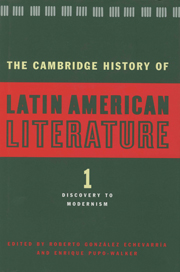Book contents
- Frontmatter
- Introduction to Volume 1
- 1 A brief history of the history of Spanish American Literature
- 2 Cultures in contact: Mesoamerica, the Andes, and the European written tradition
- 3 The first fifty years of Hispanic New World historiography: the Caribbean, Mexico, and Central America
- 4 Historians of the conquest and colonization of the New World: 1550–1620
- 5 Historians of the colonial period: 1620–1700
- 6 Colonial lyric
- 7 Epic poetry
- 8 Spanish American theatre of the colonial period
- 9 Viceregal culture
- 10 The eighteenth century: narrative forms, scholarship, and learning
- 11 Lyric poetry of the eighteenth and nineteenth centuries
- 12 Spanish American theatre of the eighteenth century
- 13 The nineteenth-century Spanish American novel
- 14 The brief narrative in Spanish America: 1835–1915
- 15 The Spanish American theatre of the nineteenth century
- 16 The essay in Spanish South America: 1800 to Modernismo
- 17 The essay of nineteenth-century Mexico, Central America, and the Caribbean
- 18 The gaucho genre
- Index
- Bibliographies
- References
14 - The brief narrative in Spanish America: 1835–1915
Published online by Cambridge University Press: 28 March 2008
- Frontmatter
- Introduction to Volume 1
- 1 A brief history of the history of Spanish American Literature
- 2 Cultures in contact: Mesoamerica, the Andes, and the European written tradition
- 3 The first fifty years of Hispanic New World historiography: the Caribbean, Mexico, and Central America
- 4 Historians of the conquest and colonization of the New World: 1550–1620
- 5 Historians of the colonial period: 1620–1700
- 6 Colonial lyric
- 7 Epic poetry
- 8 Spanish American theatre of the colonial period
- 9 Viceregal culture
- 10 The eighteenth century: narrative forms, scholarship, and learning
- 11 Lyric poetry of the eighteenth and nineteenth centuries
- 12 Spanish American theatre of the eighteenth century
- 13 The nineteenth-century Spanish American novel
- 14 The brief narrative in Spanish America: 1835–1915
- 15 The Spanish American theatre of the nineteenth century
- 16 The essay in Spanish South America: 1800 to Modernismo
- 17 The essay of nineteenth-century Mexico, Central America, and the Caribbean
- 18 The gaucho genre
- Index
- Bibliographies
- References
Summary
The costumbrista sketch
By any account the history of nineteenth-century Spanish America appears as a relentless panorama of upheaval. After gaining independence from Spain, the former colonies endured a long process of ideological and territorial fragmentation. Frail republics emerged everywhere, soon to be split up by the vicious struggles caused by caudillos and local bosses. Quite suddenly this conglomeration of independent territories faced the need to view itself as a community of nations, linked by similar institutions and a common history. Yet in those initial days of turmoil they did not find it easy to think in terms of covenants and solidarity. Chile and Brazil managed to consolidate relatively stable political systems but such was not the case in Argentina, Colombia, Mexico, and other new republics. Cuba and Puerto Rico were still lagging behind as colonial possessions. The disruptions set in motion by independence were aggravated by the territorial ambitions of foreign powers. In 1833 England occupied the Malvinas Islands; in the 1840s the United States divested Mexico of half its territory and in the early 1860s France sought to control what was left of the impoverished Mexican republic.
Predictably, the widespread turbulence reigning in nineteenth-century Spanish America is reflected in the political discourse and literary output of that period. The early novels, and, above all, the massive flow of texts produced by the costumbristas offer striking descriptions of societies besieged by uncertainties and political violence. The costumbristas practiced “the sketch of customs and manners.”
- Type
- Chapter
- Information
- The Cambridge History of Latin American Literature , pp. 490 - 535Publisher: Cambridge University PressPrint publication year: 1996



